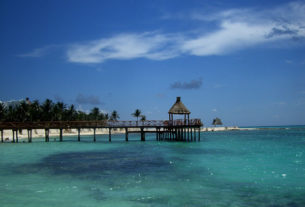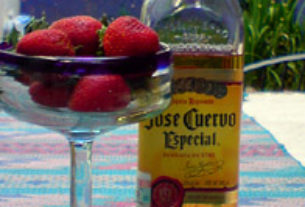Westwords
After many downhill twists and turns, at the very end of a road built for Nayarit royalty, is a little lake that could have spilled from a book of fairy tales.
La laguna Santa Maria del Oro, in the crater of a long-ago volcano, is near enough to perfect to forever please Christopher French. He’s been around and about for 30 years, always busy building cabins, nurturing a campground, pruning orange trees and encouraging flowers.

Visitors come and go, to relax or swim or hike to an abandoned gold mine. Some pursue black bass or make important checkoffs on their lifetime list of birds. Repeat visits say they love it.
“Nice place,” Chris says. “I’ve grown quite fond of it.”
There was a time when it was heaven on earth but Koala Bungalows have been struck by reality. After three decades and five children, Chris and Lya Aguayo de French are divorcing. If that isn’t bad enough, the Mexican government is dabbling and stirring. There might even be a link.
For the first time in history, a federal inspector stopped to check on the modest tourist retreat and spent hours discovering assorted violations. Fifteen days to make corrections or pay a stiff fine. Ten days were lost before Lya remembered to tell Chris of the problem.
“Serious stuff,” said Chris. “Each campsite was not clearly defined. We had no signs showing an evacuation route. There was no staff manual outlining safety procedures. There were questions about our security force.”
Christopher French, a lean, little transplanted Englishman, a nimble world traveler before he found the lake, was never a big believer in restrictive signs. No parking? No way. Keep off the grass! It’s just right for walking.
To conform to regulations, he hurriedly set out plants to mark the campground. He painted, green on white, evacuation instructions, complete with arrows, in case there is an earthquake. Simple since there’s only one way out.
French borrowed a few pages from a Tepic hotel, warning maintenance people and maids not to mop stairs during peak check-in and check-out hours. Koala has no stairs but it now has safety instructions. And, it has a new first-aid room, properly stocked with a tin of aspirin, a roll of tape, cotton balls and a bottle of rubbing alcohol.
French is Koala’s captain of security but he now has proof positive of a support staff, a photo of his brother-in-law wearing a T shirt that says “Security” across the front. A retired physician is on call — except there are no phones.
At 21, Christopher French departed England to see the world. He saw France, Spain, Australia, North Africa, Cameroon, India, Japan, Portugal, Canada, the United States, 48 countries in all. Each time he ran out of money, he got a job. Best pay was as an electrical foreman in Australia. That money bought this sizable tract on this magnificent Mexico lake. The name Koala and a carved wooden bear are his tributes.
Christopher French found Lya Aguayo when he stopped in Tepic to hone Spanish skills. At 19, she said yes indeed but her mother said wait a year. Chris worked and waited and came back for Lya’s hand in marriage. Her father said hell no and sent two toughs to chase him away.
“He called me an Australian hippy because I was wearing walking shorts in a photo I sent Lya. I was no hippy. I had short hair. He asked the British Consulate to chase me out of Mexico.”
Lya’s brother helped the couple elope. The new father-in-law stopped fretting when he heard that Chris actually had bank deposits.
“He brought us to this place for a Sunday picnic. He couldn’t understand why I wanted to buy it. He said there is nothing there — which was what I liked best.”
Not far away was a big white house overlooking the lake. It belonged to a former governor of Nayarit. Five miles of road were built so he could haul in construction materials.
Two palapa restaurants were next to cash in on the sensational setting. The Frenchs came after that. Now there are several restaurants, beautiful homes and an all-inclusive resort which charges 1,311 pesos for a Saturday night double. Koala Bungalows cost a lot less.
The lakeside community is loosely organized. It stopped raw sewage and voted out jet skis but hasn’t done anything about motorboats. It favors canoes, kayaks, more palm trees and controlled development but builders may not be following code.
The lake is awesome, maybe a mile in diameter, 200 feet deep. On still days, it reflects mountains and sky as if it were a mirror. Chris says the lake captures a lot of rainwater and probably gets an extra drink from subsurface springs.
From up above, the circle lake appears slate gray. Chris says the water has the surprising capability to turn turquoise blue. Santa Maria Resort has a blue lake picture in its promotional brochure. The lake is not so brilliant on the Koala website but the description is in four languages, Spanish, English, German and French.
Santa Maria del Oro, a village of perhaps 5,000, off highway 15 on a plateau between Guadalajara and Puerto Vallarta, was Indian country before the Spanish came in the early 1500s to search for gold. Some got rich. Some got killed.
Santa Maria del Oro undoubtedly changed a lot in the centuries between mining and farming but it appears still simple enough. On main street, pickup trucks outnumber horses about four to one.
The lake is another world, a picture postcard, an almost perfect work of art.


